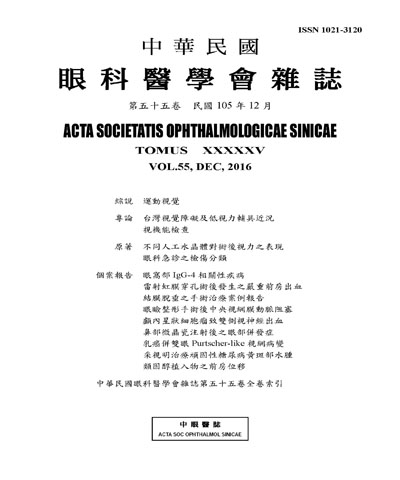
中華民國眼科醫學會雜誌
- OpenAccess
中華民國眼科醫學會,停刊
選擇卷期
- 期刊
- OpenAccess
Purpose: To present a case of ocular complication after nasal calcium hydroxylapatite injection. Methods: Case report. Results: A 24-year-old female presented with sudden onset of blurred vision in her left eye a few minutes after an injection of calcium hydroxylapatite in the nasal area. A physical examination showed limited extra-ocular movement of her left eye and left sided ptosis. Visual acuity in her left eye decreased to counting fingers at 20 cm, and a dilated pupil was also noted. She then underwent brain and orbital computed tomography and magnetic resonance imaging and the findings were normal. Acute embolic posterior ischemic optic neuropathy with ophthalmoplegia and ptosis were impressed. The patient refused further examinations and she discharged herself against our advice. Conclusion: We report a case of acute embolic posterior ischemic optic neuropathy with ophthalmoplegia and ptosis after a nasal injection of calcium hydroxylapatite. This case highlights that clinicians should be aware of the potentially disastrous ocular complications when performing nasal injections of calcium hydroxylapatite.
- 期刊
- OpenAccess
Purpose: To present a case of bilateral Purtscher-like retinopathy in a woman of advanced breast cancer. Method: Case report. Result: A 40-year-old female patient with advanced recurrent breast cancer presented bilateral Purtscher-like retinopathy. The patient had none of associated ocular history, recent head or eye trauma, and systemic disease except breast cancer. She had undergone left modified radical mastectomy for breast cancer 8 years ago and right modified radical mastectomy with neoadjuvant therapy 2 years previously. However, progressive bilateral blurred vision had developed since 1 month ago. Her best corrected visual acuity was 0.7 in both eyes. Meanwhile, bilateral peri-papillary flame-shaped hemorrhage and cottonwool spots without macula involvement were identified through ophthalmic examination. Pancytopenia and cachexia were found during hospitalization. Conslusion: This report presents a case of Purtscher-like retinopathy in a patient of advanced breast cancer with pancytopenia and cachexia. Purtscherlike retinopathy with retinal hemorrhage might be discovered in patients with advanced breast cancer without previous trauma or pancreatitis.
- 期刊
- OpenAccess
Purpose: To describe intravitreal aflibercept effectively treating for two cases with diabetic macular edema (DME) refractory to bevacizumab or ranibizumab. Methods: Case Reports. Results: The 54-year-old diabetic man complained of blurred vision in the right eye. His best corrected visual acuity (BCVA) was 20/60. Fundus fluorescein angiography showed mild non-proliferative diabetic retinopathy and clinical significant macular edema. Optical coherence tomography demonstrated cystoid macular edema with central foveal thickness (CFT) up to 354 μm. The case underwent 1.25 mg/0.05 mL of single intravitreal bevacizumab (IVB). Aggravated DME was found one month after IVB, as CFT increasing to 440 μm and BCVA reducing to 20/100. One month following two subsequent monthly IVB and posterior subtenon triamcinolone acetoine (PSTA) 20 mg, CFT further increased to 618 μm and BCVA decreased to 20/400. Because the patient with DME was refractory to bevacizumab, the patient agreed to receive 2 mg/0.05 mL of three monthly intravitreal aflibercept (IVA). His BCVA improved to 20/50 at month 3 following the last injection. The CFT dramatically decreased to 256 μm at month 3. The second case is a 62-year-old diabetic man with BCVA 20/400 in the right eye. Optical coherence tomography demonstrated CFT up to 502 μm. He underwent three monthly 0.5 mg/0.05 mL of intravitreal ranibizumab (IVR). His BCVA improved to 20/60 and CFT decreased to 296 μm. However, the following three monthly IVR paradoxically caused BCVA reducing to 20/125 and CFT increasing to 506 μm. Considering development of tachyphylaxis to ranibizumab, the treatment switched to aflibercept. After three monthly IVA, DME ameliorated as CFT down to 291 μm and BCVA up to 20/50. There was no associated systemic or ocular adverse effect in both cases. Conclusions: Intravitreal aflibercept possibly benefits for macular edema with suboptimal results on ranibizumab or bevacizumab in diabetic patients.
- 期刊
- OpenAccess
Purpose: To report a case that experienced complications after intravitreal dexamethasone implantation. Method: Case report Results: A 42-year-old female with persistent panuveitis was treated by intravitreal injection of dexamethasone implant. Unfortunately, hypotony and anterior chamber migration of the implant were noted on the first day postoperatively. Emergent surgery was performed. After a few weeks of close follow-up, a stable condition was achieved without permanent intraocular damage. Conclusion: Intravitreal injection of dexamethasone implant is usually safe and effective. However, surgically related complications may occur in patients with some complicated ocular conditions. Clinical ophthalmologists should be especially mindful of the possibility of complications following intravitreal injection of dexamethasone implant for the treatment of persistent panuveitis in such patients.

